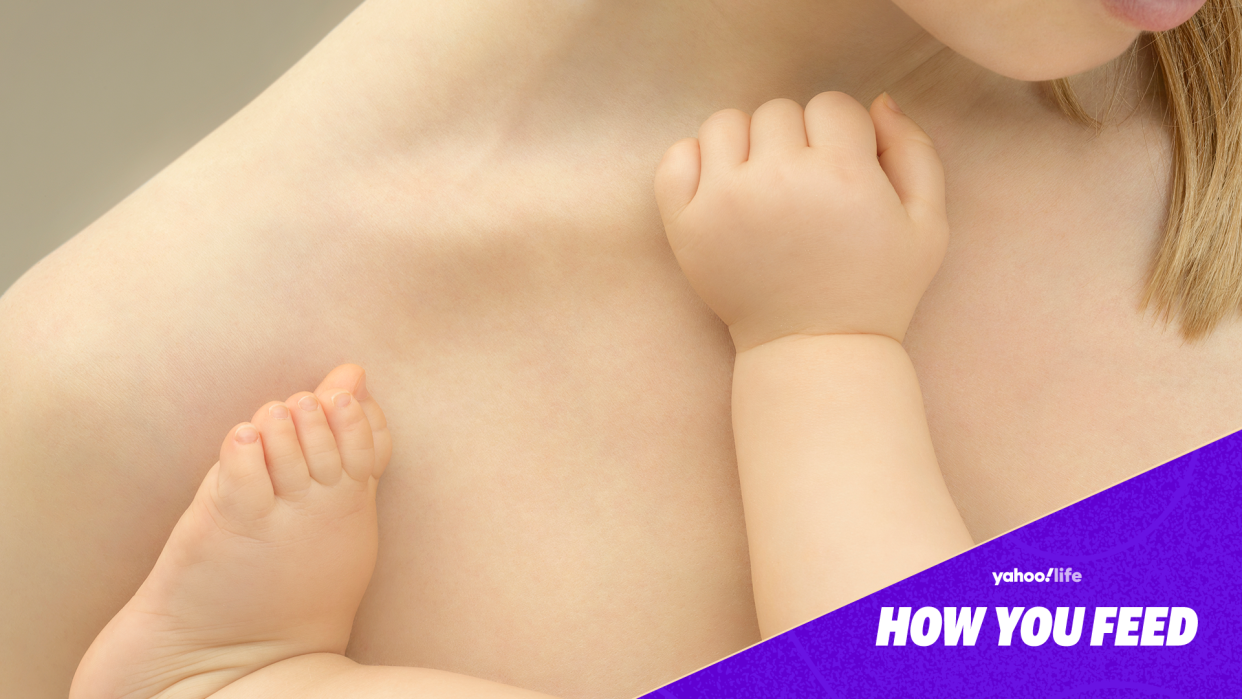How does breastfeeding actually work? Experts explain

Breast, bottle, whatever: How You Feed is a shame-free series on how babies eat.
While there are several ways to feed an infant, from pumping and bottle feeding to formula feeding, breastfeeding is the most common method. In fact, most babies — 4 out of 5 — start out being breastfed, according to the Centers for Disease Control and Prevention. But how breastfeeding works exactly can be a bit of a mystery. Where does milk actually come from? What is colostrum and why is it so important?
First, a quick anatomy lesson: Breasts are made up of several components, including the nipple and areola, mammary tissue, supporting connective tissue and fat, blood and lymphatic vessels, and nerves. “Each of these components of the breast have discrete functions,” Dr. Kjersti Aagaard, professor of obstetrics and gynecology at Baylor College of Medicine, tells Yahoo Life. “However, they work in concert and harmony to ultimately make, store and release milk.”
Here’s how it all comes together and how breastfeeding actually works.
How does lactation start?
Lactation begins at least as early as 16 weeks of pregnancy, which is in the second trimester, explains Aagaard. Throughout the end of the first trimester and the beginning of the second trimester, “rising estrogen and progesterone levels leads to an increase in the number of milk ducts in the breasts,” she says.
After delivery, these milk ducts then transport milk so it can be released from the nipple. “This ‘milk let down’ is triggered by a different set of hormones — chiefly prolactin and a cocktail of hormones” that include luteinizing hormone, follicle stimulating hormone, and gonadotropin releasing hormone, says Aagaard.
Prolactin, which is made in the pituitary gland in the brain, “is necessary for the secretion of milk by the alveoli cells,” says Aagaard. However, during pregnancy, “the rising levels of primarily estrogen and somewhat progesterone block the milk secretion action of the alveolar cells.” As Deborah Lang, lactation consultant coordinator at Johns Hopkins Medicine, puts it: “Those two hormones are the gatekeepers.”
This blocking effect is the reason why “we don’t like to prescribe estrogen-containing oral contraceptive pills — but do prescribe progestin-only pills — during the first six to eight weeks after delivery when milk production is being established,” says Aagaard.
Another hormone, oxytocin, “makes the myoepithelial cells around the alveoli contract to allow the milk, which has collected in the alveoli, flow along and fill the ducts,” explains Aagaard. In other words, “prolactin is the milk-making hormone and oxytocin is the milk-releasing hormone,” Lang tells Yahoo Life.
Oxytocin is beneficial in other ways as well, including by continuing to contract the uterus right after delivery to help control bleeding. “It is also crucially important for bonding between parents and their child,” notes Aagaard.
What exactly is colostrum and why is it important?
Colostrum is a special type of nutrient-rich milk that’s secreted in small amounts — about 40–50 ml — in the first two to three days after delivery, according to Aagaard.
When an infant is placed on the mother’s chest after being born and is able to start breastfeeding soon after, the baby will receive about “a tablespoon of colostrum,” says Lang. That may not sound like much, but Lang explains that a newborn baby’s stomach is “the size of a marble.”
There’s a reason colostrum is often referred to as “liquid gold”: “Colostrum is the ‘a lot of bang for your buck’ milk,” says Aagaard. “Colostrum is rich in immune cells and the ‘gut and lung’ antibodies (sIgA), and relative to the later milk contains a greater amount of protein, fat-soluble vitamins (A, E and K), and essential amino acids.”
Both colostrum and breast milk also contain “an amazing” substance called human milk oligosaccharides, or HMOs, which play a role in the development of a baby’s immune system, notes Aagaard. While we’re still learning more about them, research shows that HMOs may act as prebiotics and “encourage a gut bacteria population that promotes health and reduces the incidence of intestinal infections.”
What does it mean when your milk “comes in”?
This refers to when your milk starts increasing a few days after delivery. “Milk starts to be produced in larger amounts between two and four days after delivery, making the breasts feel full,” says Aagaard. “The milk is then said to have ‘come in.’”
Three days after delivery, infants normally take in about 300 to 400 ml of milk every 24 hours, and on the fifth day that rises to 500 to 800 ml per day, explains Aagaard. “From day 7 to 14, the milk is called transitional, and after two weeks it is called mature milk,” she says.
What does “the let-down” mean?
When small nerves in the breast are stimulated, such as when a baby starts breastfeeding or while pumping, this triggers a reflex that prepares breasts to release milk. “Some people feel it and some people don't,” says Lang. “As they’re nursing, they may get this tingling sensation. It's just the way the nerves are working in the breast.”

What are the benefits of skin-to-skin contact during breastfeeding?
Skin-to-skin, starting with when a baby is placed directly on the parent’s chest after birth, isn’t only a sweet way to bond — there are health benefits as well. Research shows that skin-to-skin during the first hour after delivery helps promote breastfeeding. In addition, Lang says that research shows babies who did skin-to-skin within that first hour “gained more weight, had better regulation of respiratory and arousal mechanisms,” and experienced “less infant crying.”
Aagaard says skin-to-skin post-birth “is both for the benefit of the developing infant microbiome, as well as likely for the optimized prevention of mastitis,” which is an inflammation of the breast tissue.
Skin-to-skin is also a great way for the non-breastfeeding parent to bond with and help comfort a newborn baby. “It’s a tremendous soothing technique,” says Lang.
Can you lose weight by breastfeeding?
Moms burn about an extra 500 calories per day when exclusively breastfeeding. So “some women lose weight” through breastfeeding, says Lang. But not all. According to La Leche League International, breastfeeding “may not always contribute to weight loss postpartum — many factors like pre-pregnancy weight, diet, physical activity level, etc., will impact weight loss after birth.”
The organization points out that, on average, mothers who exclusively breastfeed may lose 1 to 2 pounds per month and notes that, “over time, breastfeeding moms tend to lose more weight than mothers who do not breastfeed.”
What happens to a woman’s period while breastfeeding?
Breastfeeding triggers the release of certain pituitary hormones, including gonadotropin releasing hormone, follicle stimulating hormone, and luteinising hormone, according to the National Library of Medicine. “This [hormonal] cocktail suppresses both ovulation and menstruation, which is why exclusively breastmilk feeding folks don’t have periods and do have reduced — but not completely blocked — risk of conceiving while exclusively breastfeeding,” explains Aagaard.
Lang says the key word is “exclusively” breastfeeding — “baby at the breast, not pumping,” she says — and “then her menses should come to somewhat of a standstill.” Lang adds that if the mom returns to work and starts pumping, “then it’s a good idea to use birth control — especially in this day and age.”
There are several forms of birth control that are safe to use while breastfeeding, including mini pills (progestin-only), Skyla and Mirena IUDs, the implant and the shot, according to Planned Parenthood.
What are some of the most common complications that can happen with breastfeeding?
Breastfeeding isn’t without its challenges. Some experience sore or cracked nipples, plugged ducts and mastitis. A good latch is key to preventing sore nipples. That includes making sure the baby is nursing from most of the areola and the nipple — not just the nipple itself, according to the Office on Women’s Health. For cracked nipples, you can express some milk and use that to moisturize the area or apply purified lanolin cream that’s made for breastfeeding.
Plugged ducts are a common problem and happen when a milk duct isn’t draining properly. It can feel like there’s a tender or sore lump in the breast. Nursing from the breast with the plugged duct every two hours, along with gently massaging the area, can help loosen the plug, according to the Office on Women’s Health.
Mastitis is an inflammation of the breast tissue that can lead to an infection, so it’s important to let your health care provider know if you're experiencing symptoms. The symptoms include breasts that are warm to the touch and swollen, skin redness and fever, according to the Mayo Clinic. If there’s an infection, a 10-day course of antibiotics can help clear it up.
Fortunately, all of these conditions are “readily treatable,” says Aagaard, “and your physician or midwife provider or lactation consultant can be a great help in preventing, diagnosing and treating.”
Don't forget to #ShareHowYouFeed! Tag us to share your own feeding journey.
Wellness, parenting, body image and more: Get to know the who behind the hoo with Yahoo Life's newsletter. Sign up here.
Read more about baby feeding here:
Why is there so much shame surrounding formula and breastfeeding?
A history of breastfeeding and formula shaming: How did we get here?
What is baby-led weaning and when is the best time to start?
Is nipple confusion real? What experts say about your baby's feeding preferences
The fascinating — and controversial — history of baby formula
Mom praised for sharing TikTok of her 2-year-old respecting her boundaries while breastfeeding
Emily Ratajkowski says she is 'always' breastfeeding. Here's why nursing takes so much time.
5 reasons why breastfeeding isn’t the solution to the formula shortage

